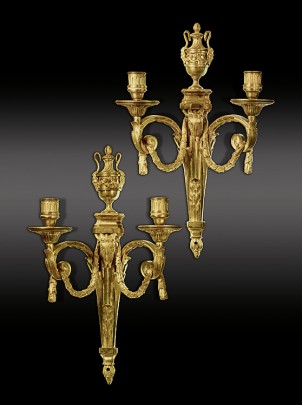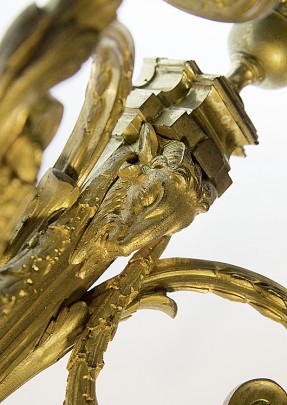A Pair of Appliques
Paris, about 1780
Bronze with original gilding
Flat ornamental pieces, no matter in what material context, very often are called „appliqués“ or (now) appliques. But the term also describes a special form of sconce. An applique (=sconce) may have one or more arms, and these may be traversable. A special form was used to light the notes when playing the concert piano. Illuminants were candles, later light bulbs, too. The form of the applique still exists today.
The appliqués originated in the gothic period, and it can be seen as a further development of the torch-holding basket or eyelet (lug). The development of an own functional form also created possibilities of a typical language of forms and a typical decoration. They were applied to the wall by discs or rosettes, wall plaques and cartouches, less often by plastic figures.
Appliques had their heyday in the rococo (Louis XV period). Usually they were produced from base metals and then fire gilt. They could possess two or three arms coming out of a common sub or socket, like bizarre, gently rolling branches, or develop into a totally asymmetrical composition.
The appliques on offer show a symmetrical design and are fixed to the wall by a fluted (channelled) pilaster strip, accompanied by leaf volutes changing into the arms and decorated with festoons. They are crowned by a so-called nestoris or trozella with a lid. The brackets for the illuminants are designed as a fluted segment of a pillar with a Tuscan capital (ring-shaped rim) on an inverted bell-shaped foot. The elaborate bracket should prevent the illuminant from toppling over.
The decoration is of the rococo type, but already shows some classicist influences.
Selection of Furniture
Commode Fireplace clock Table de Salon Commode Demi-Lune-Commode Table en chiffonnière Ladies-Voyeuse Banquette Louis XV Encrier Pair of Rococo-mirrors Table en chiffonnière Rococo-console Secrétaire à Abattant Pendule A Pair of Appliques Bureau Plat Commode Louis XV – Pierre Rousselle Satin? and amaranth tric-trac table Coiffeuse en forme de cœur A Set of four Fauteuils Commode Louis XV Tabouret Table Bouillotte et son Bouchon – Louis XVI Secretary A Pair of Fauteuils A Pair of Bergères A pair of Armchairs Bonheur-du-jour A Pair of Consoles


